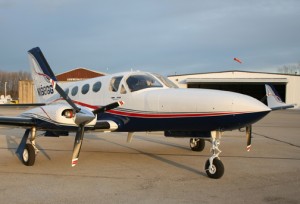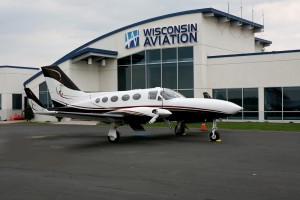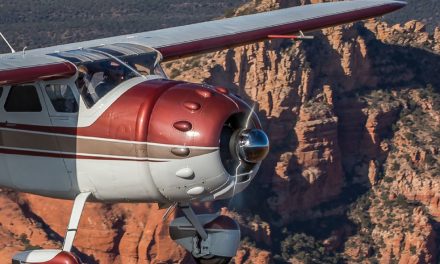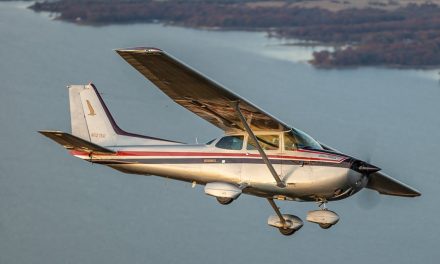 Make Way for the Chancellor!
Make Way for the Chancellor!
It may be a little hard to believe today, but there was a time when corporate piston twins were all the rage. In the early ‘80s, Piper, Cessna, Beech Commander, and Aerostar were producing a dozen different models of dedicated executive transports.
Cessna was perhaps the pre-eminent producer of corporate piston twins with a half-dozen models available to cover all contingencies. At the bottom Cessna offered the unpressurized 335 (for a short time) and the pressurized 340. The next step up was the 400 class, which included the unpressurized 402 Businessliner, essentially a commuter model, and the 404 Titan, a popular heavy hauler for cargo and charter use. Then, at the top, were the inflatable 414 Chancellor and 421 Golden Eagle, most often corporate transports.
Today, they’re all gone. Sure, you could that suggest the Beech 58 Baron remains a viable corporate transport with piston engines, but even that airplane features the narrow Bonanza cabin and omits the signature airstair door in favor of traditional over-wing entry.
Though the market was already in a downhill slide 30 years ago, two of the top models were the aforementioned Cessna 421 and 414. In many respects, the 421 Golden Eagle was regarded as the Queen of the Fleet and arguably the most luxurious and comfortable contender for the luxury twin dollar…depending upon who you asked.
The Cessna 414 Chancellor was regarded by many as a better airplane in most respects. Much of the debate stemmed from the 421’s temperamental geared Continental engines. The big turbocharged GTSIO-520s were pumped up to 375 hp and the gearing system atop the engines that reduced cruise rpm to a more civilized level was the source of continuing headaches for Cessna.
The 414 utilized essentially the same fuselage, empennage, pressurization, and fuel system as the 421 but with the 402’s wings and direct drive engines rated for only 310 hp per side. In 1981, the price difference between the two models was significant, though performance didn’t seem so dramatically divergent.
Here’s how the current (Summer 2014) Aircraft Bluebook Price Digest suggests the two models stack up:
1981 1981
Cessna 414 Cessna 421
Chancellor Golden Eagle
————— ——————
Avg Eqpd Price (new) $496,325 $579,905
Current Used Price $310,000 $370,000
Gross Wt (lbs) 6750 7450
Empty Wt (lbs) 4543 5048
Useful Ld (lbs) 2207 2402
Std Fuel Cap (gals/lbs) 213/1278 213/1278
Payload (lbs) 929 1124
Takeoff Dist (ft) 2185 1786
Climb (fpm) 1520 1940
S/E Climb (fpm) 290 350
S/E Serv Clg (ft) 13340 14900
Max Cruise-FL250 (kts) 224 241
It’s apparent from the numbers above that the extra $84,000 bought a little more payload, climb, and short field performance, but cruise and single-engine ascent didn’t improve that much. (Realistic cruise numbers for the two airplanes suggest the gap may have been closer to 10 than 17 knots—about 210-215 kts for the 414 and 220-225 knots for the 421. Still, both airplanes easily managed to exceed the 200-knot bottom line considered so essential for a corporate twin.)
Of course, another obvious benefit of the smaller engines was/is reduced fuel burn. Specific fuel consumption (sfc) is fairly immutable, and both airplanes sport a sfc on the order of .44 pounds/hp/hr. In other words, at 75 percent power, you could expect a fuel burn of roughly 17 gph per engine in the 414 and 21 gph in the 421. In real terms, a 34-gph burn in the 414 will cost you about $220/hr, a 42-gallon consumption would be $273/hr in the 421. That’s about 25 percent higher burn in exchange for only five percent better cruise.
Yes, I know – if you have to ask how much…? Still, fuel economy is becoming progressively more important as supply becomes constricted and prices reach toward European levels.
The basic 414 was born in 1970 with a 4.2 psi pressurization differential and ascended to become the Chancellor in 1978. The updated Chancellor abolished the original tip tanks in favor of a longer wet wing, benefitted from a lengthened fuselage, mounted an improved 5.0 psi pressurization system, and enjoyed a 400-pound heavier gross weight. The result was an airplane that was physically almost identical to the 421, but with slightly less power.
(In fact, a company in Waco, Texas, RAM Aircraft, offers a popular mod that upgrades the engines to as much as 335 hp/side for stronger climb and improved cruise.)
Pressurization differential is an impressive 5.0 psi on the later 414s, generating a comfortable 8000-foot cabin at 25,000 feet. In fact, however, the 414 is most often operated in the low flight levels, FL180 to FL220. It’s most comfortable at those heights and will still turn in the magic 200 knots. Pressurization has always been the ultimate luxury, one of those systems—like air conditioning in cars—that seems almost mandatory.
It’s also important to remember that even 18,000 feet without oxygen masks is a major victory for pilots and passengers. (Cessna’s 210 and 337 were back-engineered to accept pressurization and employed a 3.4 psi system that allowed a 10,000 foot cabin at 20,000 feet— not outstanding but certainly adequate most of the time.)
Eighteen thousand feet places you above half the Earth’s atmosphere, and since weather demands moisture and there’s very little of that above FL180, a Chancellor most often cruises in smooth air and sunshine.
It’s an eminently comfortable ride, too. The eight-seat cabin measures 55 inches across, making it one of the roomiest in the class. It’s also 51 inches high—not nearly tall enough for stand-up headroom, but big enough to allow easy walk-around space inside the cabin.
From a pilot’s point of view, the front office is easily accessible and well laid out, with everything logically oriented in a left-right format. Engine start is about as simple as it gets – full rich, mags, master, prime, starter. The Chancellor comes off the blocks with minimum breakaway power, and differential thrust is rarely necessary for directional control unless you’re trying to maneuver in a confined space.
Climb isn’t in the Apollo class, but the airplane does very well once it’s sped up and cleaned up. Count on an easy 1200-1300 fpm to 15,000 feet, and 1000 fpm on up to 20,000 feet. With the strong pressurization system cranked up to max, there’s not much reason to level lower than about 16,500/17,500 if you prefer VFR or FL180/FL200 if you’re filed IFR.
Cruise performance may not be quite what you expect from the manual, but most Chancellor owners are content with the airplane’s cross country speed. I’ve delivered perhaps a dozen Chancellors domestically and internationally, and the airplane is good for a solid 200 knots up high, 180-185 knots down low. I imagine a perfectly-rigged and tuned Chancellor might touch 215 knots at 24,000 feet, but that’s probably the realistic limit.
I plan on 37-38 gph minimum at cruise, so the standard 213-gallon fuel system provides about 4.5 hours endurance plus reserve. Even at 190 knots, that’s adequate for 850 nm between fuel and food stops. The nice thing is that everyone in the airplane is comfortable, with fold-down tables in back and plenty of elbow and head room for every seat.
It’s a reasonably peaceful environment, as well—one of the quietest you’ll find in a piston twin. Conversations barely above a whisper are easily audible, there’s little vibration transmitted through the fuselage, and the chairs articulate in all the proper directions. Additionally, the airplane takes turbulence well, with a high wing loading of nearly 30 pounds/square foot.
Couple the whole package with a good autopilot and you have a truly smooth and luxurious mode of travel. At reduced fuel levels, I’ve transported six in comfort in a 414. I’ve also loaded them up 1500 pounds over gross with ferry fuel for the Atlantic or Pacific and saw very little speed loss. Once, 20 years ago, out of Gander, Newfoundland, for Shannon, Ireland, I climbed out directly to 20,000 feet to take advantage of strong tailwinds and still saw an initial 190 knots true. With the help of the wind, I did the 1717 nm from Gander to Shannon in just under seven hours, averaging nearly 250 knots.
At the end of your flight, whether IFR or VFR, the Chancellor is one of the most manageable of the corporate twins. Unlike the 421’s geared powerplants, the 414’s engines aren’t unduly sensitive to power reductions. The airplane will accept approach speeds anywhere from 100 to 120 knots, and it’s as stable on a long VFR straight into Long Beach in good weather as it is to a tight ILS to minimums at Wichita in a snowstorm.
Like most other Cessna piston products, the 414 Chancellor was discontinued in the mid-‘80s after some 1100 had been sold, and many of those are still active. Despite the airplane’s age, it remains a popular corporate transport, reasonably economical to operate, simple to fly, fairly easy to maintain, and a popular machine with both pilots and passengers.
In today’s soft market, you can find late-model Chancellors in good shape for $300,000. Of course, that’s just the price of admission, and any intelligent twin buyer should be careful to consider upkeep and normal operating costs. ANY 30-year-old piston twin is bound to have a few maintenance issues. You need to iron those out before the sale or negotiate a lower price to cover the deficiencies.
Exhaust systems are always a concern on the older TSIO-520 Continentals, and turbochargers can also demand major attention (read EXPENSIVE). Pressurization can be problematic, as well. The system may begin to leak after a few years, partially nullifying the whole reason for buying an inflatable airplane in the first place.
As time marches on, most pilots eventually stop marching altogether. Chancellors can be made timeless, however, with indefinite lives extended by new engines, improved avionics, and modernized components. The 414 may be a tad slower than the 421, but it’s also less expensive to buy and operate, easier to fly, and it’s one of those airplanes that hardly anyone dislikes.





